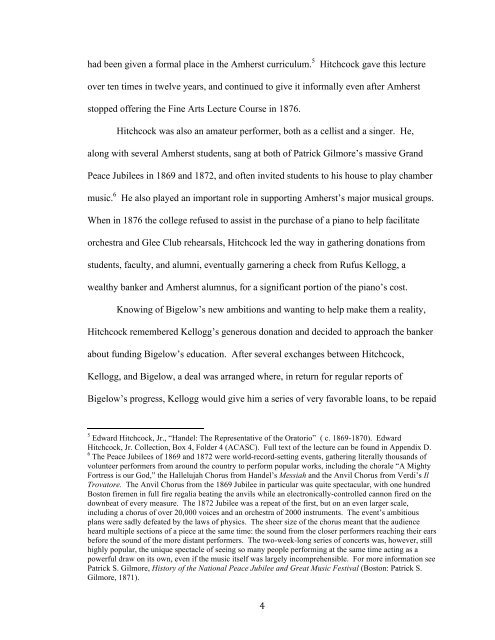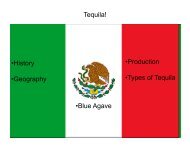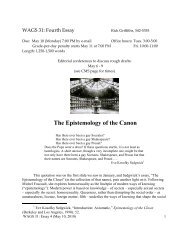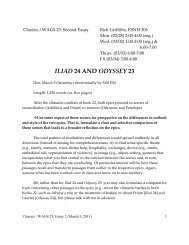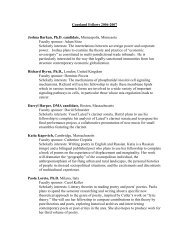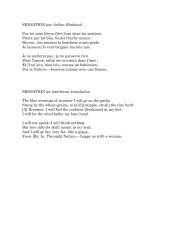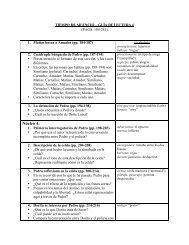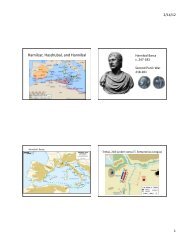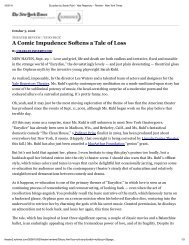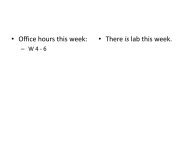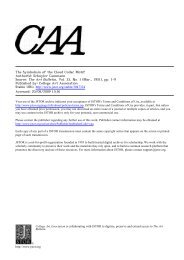Finding Their Voices - Amherst College
Finding Their Voices - Amherst College
Finding Their Voices - Amherst College
You also want an ePaper? Increase the reach of your titles
YUMPU automatically turns print PDFs into web optimized ePapers that Google loves.
had been given a formal place in the <strong>Amherst</strong> curriculum. 5<br />
Hitchcock gave this lecture<br />
over ten times in twelve years, and continued to give it informally even after <strong>Amherst</strong><br />
stopped offering the Fine Arts Lecture Course in 1876.<br />
Hitchcock was also an amateur performer, both as a cellist and a singer. He,<br />
along with several <strong>Amherst</strong> students, sang at both of Patrick Gilmore’s massive Grand<br />
Peace Jubilees in 1869 and 1872, and often invited students to his house to play chamber<br />
music. 6<br />
He also played an important role in supporting <strong>Amherst</strong>’s major musical groups.<br />
When in 1876 the college refused to assist in the purchase of a piano to help facilitate<br />
orchestra and Glee Club rehearsals, Hitchcock led the way in gathering donations from<br />
students, faculty, and alumni, eventually garnering a check from Rufus Kellogg, a<br />
wealthy banker and <strong>Amherst</strong> alumnus, for a significant portion of the piano’s cost.<br />
Knowing of Bigelow’s new ambitions and wanting to help make them a reality,<br />
Hitchcock remembered Kellogg’s generous donation and decided to approach the banker<br />
about funding Bigelow’s education. After several exchanges between Hitchcock,<br />
Kellogg, and Bigelow, a deal was arranged where, in return for regular reports of<br />
Bigelow’s progress, Kellogg would give him a series of very favorable loans, to be repaid<br />
!!!!!!!!!!!!!!!!!!!!!!!!!!!!!!!!!!!!!!!!!!!!!!!!!!!!!!!!<br />
5 Edward Hitchcock, Jr., “Handel: The Representative of the Oratorio” ( c. 1869-1870). Edward<br />
Hitchcock, Jr. Collection, Box 4, Folder 4 (ACASC). Full text of the lecture can be found in Appendix D.<br />
6 The Peace Jubilees of 1869 and 1872 were world-record-setting events, gathering literally thousands of<br />
volunteer performers from around the country to perform popular works, including the chorale “A Mighty<br />
Fortress is our God,” the Hallelujah Chorus from Handel’s Messiah and the Anvil Chorus from Verdi’s Il<br />
Trovatore. The Anvil Chorus from the 1869 Jubilee in particular was quite spectacular, with one hundred<br />
Boston firemen in full fire regalia beating the anvils while an electronically-controlled cannon fired on the<br />
downbeat of every measure. The 1872 Jubilee was a repeat of the first, but on an even larger scale,<br />
including a chorus of over 20,000 voices and an orchestra of 2000 instruments. The event’s ambitious<br />
plans were sadly defeated by the laws of physics. The sheer size of the chorus meant that the audience<br />
heard multiple sections of a piece at the same time: the sound from the closer performers reaching their ears<br />
before the sound of the more distant performers. The two-week-long series of concerts was, however, still<br />
highly popular, the unique spectacle of seeing so many people performing at the same time acting as a<br />
powerful draw on its own, even if the music itself was largely incomprehensible. For more information see<br />
Patrick S. Gilmore, History of the National Peace Jubilee and Great Music Festival (Boston: Patrick S.<br />
Gilmore, 1871).<br />
! 4!


